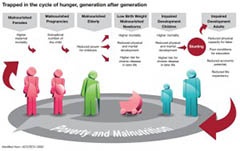The following post by IFPRI Director General Shenggen Fan was originally published on his DG Corner blog.
Hunger and undernutrition are said to be causes of poverty, and these concepts are often discussed together. However, the relationship between hunger, undernutrition, and poverty is often not fully understood.
Prevailing thinking considers extreme poverty to be the root cause of hunger and undernutrition, often in a one-way relationship. With the world producing more than 2,700 calories of food per person, it is sensible—though oversimplified—to view hunger as a problem resulting from extreme poverty. The rationale is that if the poor had enough resources to access food, hunger and undernutrition would be eliminated.
In reality, hunger and undernutrition are also major causes of poverty, resulting in a two-way relationship.
Hunger and undernutrition have debilitating physical effects, such as diminished labor productivity. With roughly 70 percent of the world’s hungry dependent on agriculture for their livelihoods, many undernourished people are not able to fully use their labor (their most available asset) to help climb out of poverty. Also, children who suffer from impeded physical growth and the related cognitive deficits attain fewer grades of schooling, have poorer cognitive skills, lower wages and are more likely to live in poverty.
Furthermore, the life cycle of undernutrition persists for generations. Women affected by stunting as children are more likely to have children who also suffer from undernutrition, and live in poor households as adults. With 805 million people in the world still hungry, and one in five children stunted, we simply cannot end cycles of poverty without addressing the magnitude of hunger we see today.
The economic burden of undernutrition, for example, and its impacts on poverty have reached global proportions. Every year, US$ 1.4-2.1 trillion, or 2-3 percent of global GDP, is lost due to undernutrition. In some countries such as Ethiopia, the cost of undernutrition can amount to as much as 16.5% of GDP. And remember, it is primarily the poor and hungry who experience these losses. Eliminating hunger and undernutrition means putting more money in poor people’s pockets and allowing them to lead healthy lives, thereby contributing directly to ending extreme poverty.
At the recently concluded UN General Assembly in New York, where I participated in a number of high-level meetings, the discussions focused on key global challenges, particularly conflict and terrorism, transboundary animal-borne diseases (Ebola), and climate change. Tackling these challenges will be essential to achieving a healthy, sustainable, and resilient global food system—which in turn contributes to achieving multiple sustainable development goals.
Moving forward, hunger and poverty need not compete for priority. However, the central role that food security and nutrition play in ending poverty must be reflected in the Sustainable Development Goals (SDGs)—the anchor of the post-2015 development agenda.
There is mounting evidence of the economic and social benefits of improving food security and nutrition. In Indonesia, workers who received iron-intake interventions were able to reduce anemia, improve productivity, and boost income in a cost-effective way. Also, we have seen many examples of effective nutrition interventions that boost children’s health, education, and opportunities to succeed. The benefits of investing in child nutrition far exceed the costs—every dollar spent in reducing child undernutrition in India, for example, has a $34 payoff.
With the right focus and urgency, and a truly global partnership, we can achieve so much. The past 15 years under the MDGs suggests this. But we can, and should, do more.







